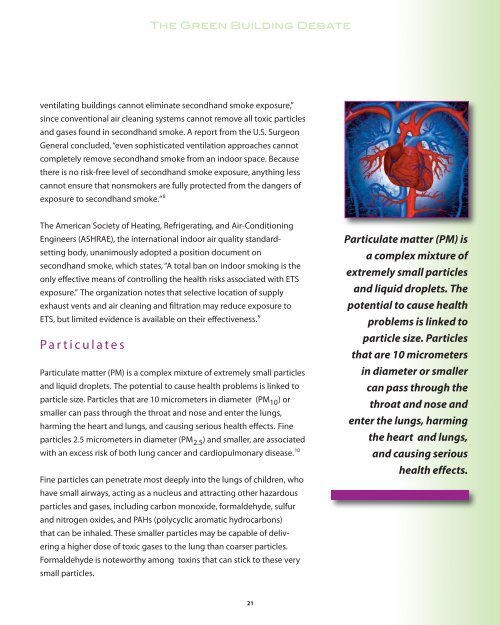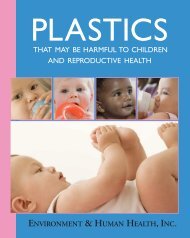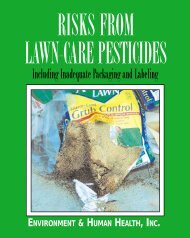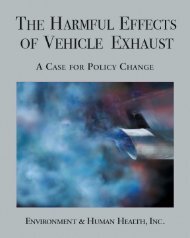LEED Report - Environment & Human Health, Inc.
LEED Report - Environment & Human Health, Inc.
LEED Report - Environment & Human Health, Inc.
- No tags were found...
Create successful ePaper yourself
Turn your PDF publications into a flip-book with our unique Google optimized e-Paper software.
The Green Building Debateventilating buildings cannot eliminate secondhand smoke exposure,”since conventional air cleaning systems cannot remove all toxic particlesand gases found in secondhand smoke. A report from the U.S. SurgeonGeneral concluded, “even sophisticated ventilation approaches cannotcompletely remove secondhand smoke from an indoor space. Becausethere is no risk-free level of secondhand smoke exposure, anything lesscannot ensure that nonsmokers are fully protected from the dangers ofexposure to secondhand smoke.” 8The American Society of Heating, Refrigerating, and Air-ConditioningEngineers (ASHRAE), the international indoor air quality standardsettingbody, unanimously adopted a position document onsecondhand smoke, which states, “A total ban on indoor smoking is theonly effective means of controlling the health risks associated with ETSexposure.” The organization notes that selective location of supplyexhaust vents and air cleaning and filtration may reduce exposure toETS, but limited evidence is available on their effectiveness. 9P a r t i c u l a t e sParticulate matter (PM) is a complex mixture of extremely small particlesand liquid droplets. The potential to cause health problems is linked toparticle size. Particles that are 10 micrometers in diameter (PM 10 ) orsmaller can pass through the throat and nose and enter the lungs,harming the heart and lungs, and causing serious health effects. Fineparticles 2.5 micrometers in diameter (PM 2.5 ) and smaller, are associatedwith an excess risk of both lung cancer and cardiopulmonary disease. 10Fine particles can penetrate most deeply into the lungs of children, whohave small airways, acting as a nucleus and attracting other hazardousparticles and gases, including carbon monoxide, formaldehyde, sulfurand nitrogen oxides, and PAHs (polycyclic aromatic hydrocarbons)that can be inhaled. These smaller particles may be capable of deliveringa higher dose of toxic gases to the lung than coarser particles.Formal dehyde is noteworthy among toxins that can stick to these verysmall particles.Particulate matter (PM) isa complex mixture ofextremely small particlesand liquid droplets. Thepotential to cause healthproblems is linked toparticle size. Particlesthat are 10 micrometersin diameter or smallercan pass through thethroat and nose andenter the lungs, harmingthe heart and lungs,and causing serioushealth effects.21







